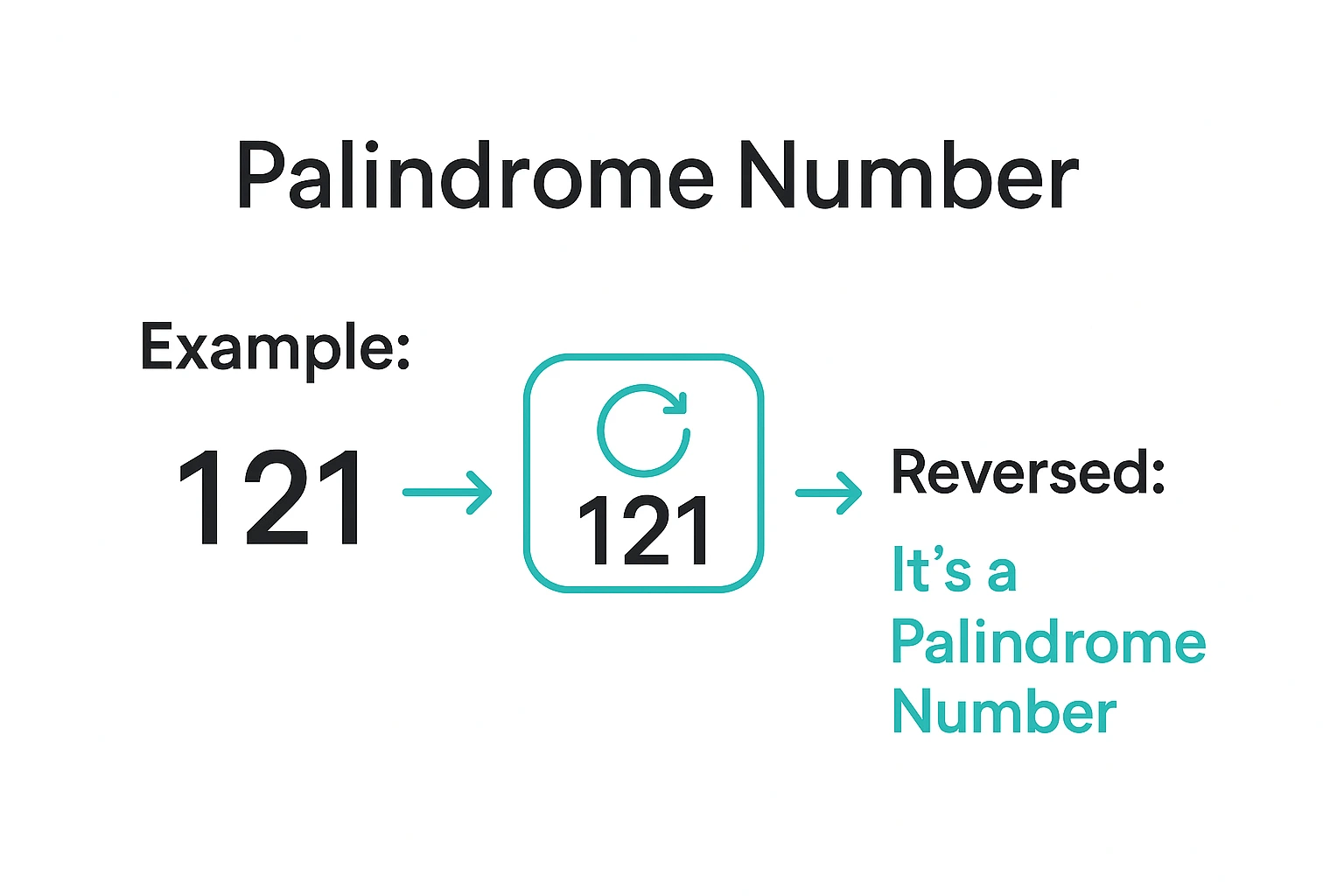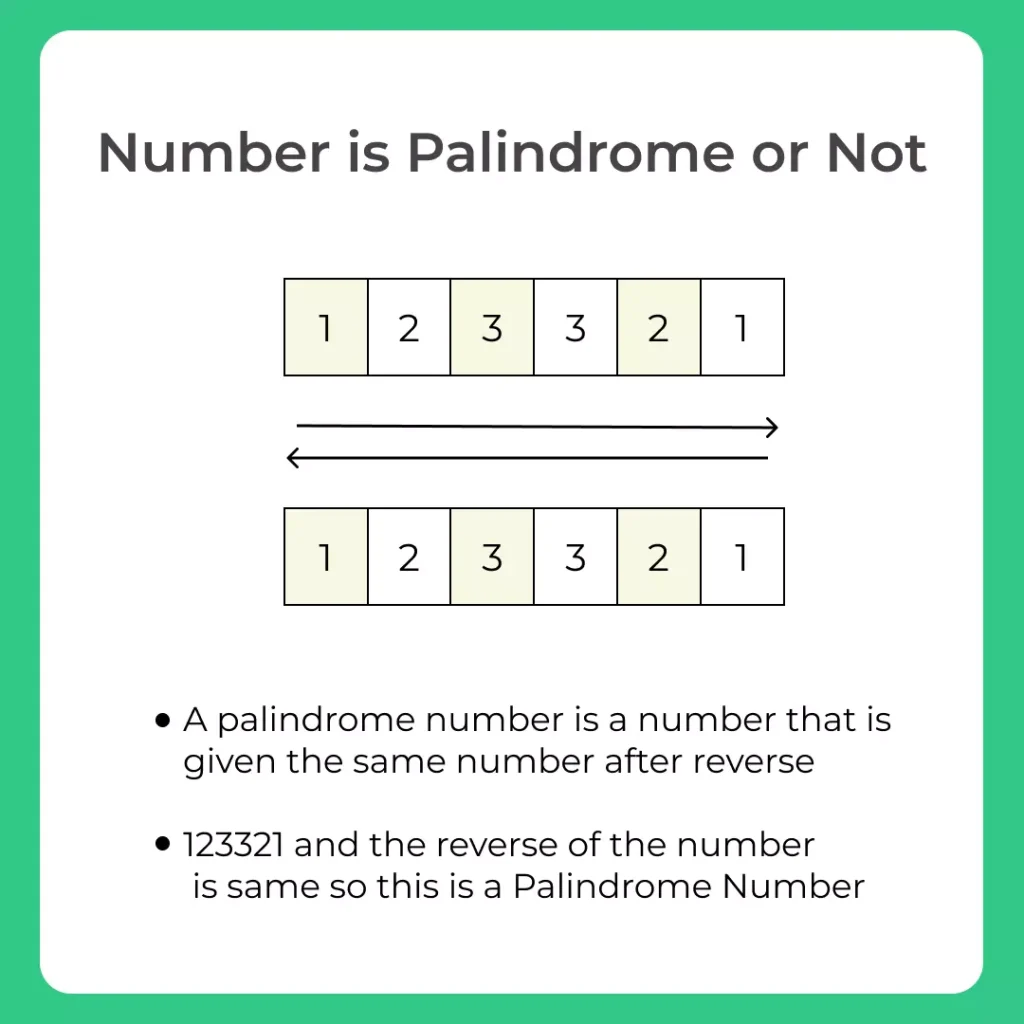Palindrome Program in Python
Check Whether or Not the Number is a Palindrome in Python
Palindrome Program in Python – Given an integer number as an input, the objective is to check Whether or not the number is a palindrome. Therefore, we write a code to Check Whether or Not the Number is a Palindrome in Python Language.
Example
Input : 1221
Output : Palindrome

Check Whether or Not the Number is a Palindrome in Python Language
Check Whether or Not the Number is a Palindrome in Python Language
A Palindrome Number in Python is a number that remains the same when its digits are reversed. In simple terms, if you read the number forward or backward, it looks the same.


Given an integer input the objective is to check whether or not the given integer number as an input is palindrome or not.
For a number to be a Palindrome, the number must be the same when reversed. If the number doesn’t match the reverse of itself, the number is not a Palindrome.
- Method 1: Using Simple Iteration.
- Method 2: Using String Slicing.
- Method 3: Using Recursion
- Method 4: Using Character matching
- Method 5: Using Character matching updated
- Method 6: Using Built-in reversed function
- Method 7: Building reverse one char at a time
- Method 8: Using Flag and backward reading
- Method 9: Bonus using backward slicing
We’ll discuss the above-mentioned methods in detail in the sections below. Don’t forget to check the blue box mentioned below for better understanding of the problem.

Method 1: Using Simple Iteration
Working
For a given integer variable, we perform the following operations,
- Run a While loop with condition as temp number < 0.
- Using modulo operator, extract the last digit from the number.
- Using the formula reverse = reverse * 10 + remainder , we’ll keep updating the reverse variable.
- Using the divide operator, we’ll shorten the number.
- Check if the reversed number matches the original number.
Let’s implement the above mentioned code in Python Language.
Python Code
num = 1221
temp = num
reverse = 0
while temp > 0:
remainder = temp % 10
reverse = (reverse * 10) + remainder
temp = temp // 10
if num == reverse:
print('Palindrome')
else:
print("Not Palindrome")Output
Palindrome
Method 2: Using String Slicing
Working
In this method we’ll convert the number to string format and reverse the string. We’ll check if the reversed number matches the original one at the end.
For an integer input number, we perform the following operations,
- Convert the number to string format using str() function.
- Using string slicing, reverse the number.
- Check if the reversed number matches the original number.
Let’s implement the above mentioned logic in Python Language.
Python Code
num = 1234
reverse = int(str(num)[::-1])
if num == reverse:
print('Palindrome')
else:
print("Not Palindrome")Output
Not Palindrome
Prime Course Trailer
Related Banners
Get PrepInsta Prime & get Access to all 200+ courses offered by PrepInsta in One Subscription
Method 3: Using Recursion
Working
In this method we’ll use recursion. To know more about recursion, check our page, Recursion in Python.
For a given integer number as input we perform the following,
- Define a function recurrev() which takes the number and the reverse variable as arguments.
- Set the base case as number == 0 and the step recursive call as recurrev(number//10,reverse).
- Check if the returned value matches the original number.
Let’s implement the above mentioned logic in Python Language.
Python Code
def recurrev(number, rev):
if number == 0:
return rev
remainder = int(number % 10)
rev = (rev * 10) + remainder
return recurrev(int(number / 10), rev)
num = 12321
reverse = 0
reverse = recurrev(num, reverse)
print(str(num) + " is: ", end="")
print("Palindrome") if reverse == num else print("Not Palindrome")
Output
Palindrome
Method 4: Using Character matching
Working
For string str iterate on the whole check if we find any condition such that –
- str[i] != str[len(str) – i – 1]
- If yes then its not a palindrome
Basically, we are checking ‘i’th character is the same as ‘i’th character from the end or not
def checkPalindrome(str):
# check if str[i] is same as str[len(str) - i - 1]
# for whole string
for i in range(0, len(str)):
# Basically, we are checking i-th character is
# same as i-th character from the end or not
if str[i] != str[len(str) - i - 1]:
return False
return True
# main function
s = "kayak"
print("Palindrome") if checkPalindrome(s) else print("Not Palindrome")
Output
Palindrome
Method 5: Using Character matching (Updated)
Working
The logic is same as the previous method with the only difference that –
Rather than iterating on the whole string, we iterate on half of the string input.
Since, if the string is a palindrome, the first half will be the same as the second half from the end.
# we do not need to check the whole string
# only till the mid of string
# as if it palindrome the first half == second half of string when read backwards
def checkPalindrome(str):
# Run loop from 0 to len/2
mid = int(len(str) / 2)
for i in range(0, mid):
if str[i] != str[len(str) - i - 1]:
return False
return True
# main function
s = "kayak"
print("Palindrome") if checkPalindrome(s) else print("Not Palindrome")
Output
Palindrome
Method 6: Using In-Built reversed function
Working
Use the following –
reverse = ”.join(reversed(str))
def checkPalindrome(str):
# using inbuilt reversed function
reverse = ''.join(reversed(str))
if str == reverse:
return True
return False
# main function
s = "kayak"
print("Palindrome") if checkPalindrome(s) else print("Not Palindrome")
Output
Palindrome
Method 7: Building reverse one char at a time
The explanation is given in the comments section of the code below –
string = "123"
# this will automatically generate reverse
rev = ""
for char in string:
rev = char + rev
print("Palindrome") if string == rev else print("Not Palindrome")
print("string: " + str(string))
print("rev: " + str(rev))
Output
Not Palindrome
string: 123
rev: 321
Method 8: Using Flag
The explanation is given in the comments section of the code below –
string = "radar"
j = -1
flag = 0
for char in string:
# char starts from index 0
# string[j] forces to read from end
# bcz negative index are read from end
if char != string[j]:
flag = 1
break
j = j - 1
print(string + " is : ", end="")
print("Not Palindrome") if flag else print("Palindrome")
Output
radar is : Palindrome
Method 9: Bonus using backward slicing
We use backward looping/slicing in a for loop here
str1 = "radar"
n = len(str1)
c = []
for i in range(n - 1, -1, -1):
c.append(str1[i])
rev = "".join(c)
print(str1 + " is: ", end="")
if str1 == rev:
print("Palindrome")
else:
print("Not Palindrome")
Output
radar is : Palindrome
Prime Course Trailer
Related Banners
Get PrepInsta Prime & get Access to all 200+ courses offered by PrepInsta in One Subscription
FAQs - Palindrome Number in Python
No, negative numbers are not considered palindromes. This is because the minus sign (-) is not mirrored at the end of the number when reversed. For example, -121 becomes 121- when reversed, which is not the same as the original number.
Yes, you can check for a palindrome without converting the number to a string by reversing the number mathematically. Here’s how you can do it:
def is_palindrome(x): if x < 0: return False original = x reversed_num = 0 while x != 0: digit = x % 10 reversed_num = reversed_num * 10 + digit x //= 10 return original == reversed_num
This method avoids string conversion and is often used in coding interviews.
Yes, all single-digit numbers (0 through 9) are palindromes. They read the same forward and backward.
The most straightforward and efficient method is to convert the number to a string and compare it with its reverse:
def is_palindrome(x): return str(x) == str(x)[::-1]
This approach is concise and works well for most use cases.
This is a common interview question. To determine if a number can become a palindrome by removing at most one digit, you can use a two-pointer approach:
def valid_palindrome(s): def is_palindrome_range(i, j): return all(s[k] == s[j - k + i] for k in range(i, j)) s = str(s) i, j = 0, len(s) - 1 while i < j: if s[i] != s[j]: return is_palindrome_range(i+1, j) or is_palindrome_range(i, j-1) i += 1 j -= 1 return True
This function checks if the string representation of the number can become a palindrome by removing at most one character.
- Positive or Negative number: C | C++ | Java | Python
- Even or Odd number: C | C++ | Java | Python
- Sum of First N Natural numbers: C | C++ | Java | Python
- Sum of N natural numbers: C | C++ | Java | Python
- Sum of numbers in a given range: C | C++ | Java | Python
- Greatest of two numbers: C | C++ | Java | Python
- Greatest of the Three numbers: C | C++ | Java | Python
- Leap year or not: C | C++ | Java | Python
- Prime number: C | C++ | Java | Python
- Prime number within a given range: C | C++ | Java | Python
- Sum of digits of a number: C | C++ | Java | Python
- Reverse of a number : C | C++ | Java | Python
- Palindrome number: C | C++ | Java | Python
- Armstrong number : C | C++ | Java | Python
- Armstrong number in a given range : C | C++ | Java | Python
- Fibonacci Series upto nth term : C | C++ | Java | Python
- Find the Nth Term of the Fibonacci Series : C | C++ | Java | Python
- Factorial of a number : C | C++ | Java | Python
- Power of a number : C | C++ | Java | Python
- Factor of a number : C | C++ | Java | Python
- Strong number : C | C++ | Java | Python
- Perfect number : C | C++ | Java | Python
- Automorphic number : C | C++ | Java | Python
- Harshad number : C | C++ | Java | Python
- Abundant number : C| C++ | Java | Python
- Friendly pair : C | C++ | Java | Python
Get over 200+ course One Subscription
Courses like AI/ML, Cloud Computing, Ethical Hacking, C, C++, Java, Python, DSA (All Languages), Competitive Coding (All Languages), TCS, Infosys, Wipro, Amazon, DBMS, SQL and others






n = int(input(“enter a number: “))
x = str(n)[::-1]
y = int(x)
print(y)
if n==y:
print(‘n is pallindrome’)
else:
print(‘not pallindrome’)
a=int(input())
temp=a
rev=0
while(a>0):
rem=a%10
rev=(rev*10)+rem
a=a//10
if(temp==rev):
print(‘it is a Palindrome ‘,rev,’ ,’,temp)
else:
print(‘it is not a Palindrome ‘,rev,’ ,’,temp)
x = input(“Enter a Number: “)
a = str(x)[::-1]
if x == a:
print(“{}”.format(x), “is Palindrome”)
else:
print(“{}”.format(x), “is not Palindrome”)
x = input()
z = list(x)
z.reverse()
a = “”.join(z)
if x == a:
print(“{} is palidrome”.format(x))
else:
print(“{} is not palidrome”.format(x))
a = int(input(“Enter The Number: \n”))
b = (str(a)[::-1])
print(b)
if a==int(b):
print(“The number is palindrome”)
else:
print(“The number is not palindrome”)
#Finding palindrome or not
a = list(map(str,input()))
print(“Palindrome” if a == a[::-1] else “not palindrome”)
num =str(input())
print(“The number is “,num)
pal = num[::-1]
if num == pal:
print(“The entered no. is Pal”)
else:
print(“The entered no. is not Pal”)
n = input(“enter:”)
p = n[::-1]
if n == p:
print(“Palindrome found”,n)
else:
print(“Not Palindrome”)
#palindrome or not
n=input()
if n==n[::-1]:
print(“Palindrome”)
else:
print(“No Palindrome”)
m=input(“enter word”)
n=m[::-1]
if n==m:
print(“palindrome”)
else:
print(“not”)
count=0
st=[str(n) for n in input() ]
l=len(st)
for i in range(0, int(l/2)+1):
if(st[i]==st[l-1]):
count=count+1
l=l-1
break
if (count>0):
print(“palindrome”)
else:
print(“not palindrome”)
x = input ()
y = str(x)[::-1]
if x == y:
print(“Palindrome”)
else :
print(“Sorry”)